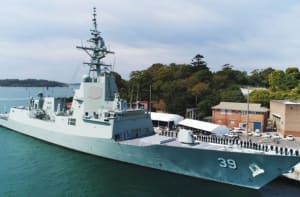Julian Kerr |Sydney
The first of the three 7,000-tonne Hobart class guided missile destroyers (DDGs) destined for the RAN was formally commissioned on 23 September and is expected to be available for operations late in 2018 – about the time the second of the class will be delivered to Navy prior to commissioning.
Unsurprisingly, the induction of HMAS Hobart at Fleet Base East was attended by Prime Minister Malcolm Turnbull, Defence Minister Marise Payne, ADF Chief Mark Binskin, and the heads of Navy and Army, along with a bevy of senior Defence officials and industry executives.
Unsurprisingly, not only because of the high profile of a program that has had its challenges, but also to acknowledge the impressive first-of-type it has produced.
Delivery of then NUSHIP Hobart to Defence in June for final trials prior to commissioning was two years and seven months behind the original schedule - itself rebaselined three times, most recently in 2015 - and nearly 17 years since the DDG construct was first made public in the 2000 Defence White Paper.
Significant improvements in the construction process mean Ship 2 Brisbane is now tracking to meet its rescheduled delivery date of September 2018, while delivery of Ship 3 Sydney has been advanced from March 2020 to December 2019.
The final cost of the program has been forecast in the 2017-18 federal budget defence portfolio statements as $9.09 billion – some $1.25 billion in outturned dollars over the original budget but in line with projected costs following a comprehensive reset of the enterprise in 2015.
Air Chief Marshal Binskin described HMAS Hobart as a quantum leap in Australia’s maritime capabilities.
And Prime Minister Turnbull referred to the “brinkmanship” of North Korean leader Kim Jong-un and stressed the criticality of a strong and well-equipped ADF “in these uncertain times.”
Although first-of-class flight trials to integrate the MH-60R naval combat helicopter on Hobart will take place early in 2018, storing and deploying anti-surface AGM-114 Hellfire missiles for the helicopter will not occur until magazine armour is enhanced during the ship’s first docking period in 2019.
Hobart’s year-long workup period will culminate in US Navy Combat System Ship Qualification Trials (CSSQT) in the final quarter of 2018.
These will include firings over the US Navy Test Range off San Diego of the ship’s Standard SM-2 Block IIIA/B and Evolved SeaSparrow (ESSM) anti-air missiles.
The developments in Northeast Asia referred to by Prime Minister Turnbull suggest an early focus is likely on the combat system and missile loadout upgrades necessary for the DDGs to offer a terminal phase ballistic missile defence capability.




